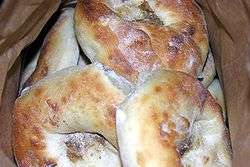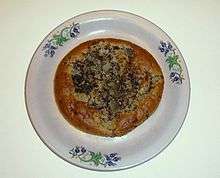Bialy (bread)
 | |
| Alternative names | biały |
|---|---|
| Type | Bread |
| Course | Breakfast, Brunch |
| Place of origin | Poland |
| Region or state | Central Europe |
| Main ingredients | Flour |

Bialy (Yiddish: ביאלי), a Yiddish word short for biały or bialystoker kuchen (Yiddish: ביאליסטאקער קוכען), from the city of Białystok in Poland,[1] is a small roll that is a traditional dish in Polish and Polish Ashkenazi cuisine. A traditional bialy, or cebularz as it is known in Poland, has a diameter of up to 15 cm (6 inches) and is a chewy yeast roll similar to a bagel. Unlike a bagel, which is boiled before baking, a bialy is simply baked, and instead of a hole in the middle it has a depression. Before baking, this depression is filled with diced onions and other ingredients, including (depending on the recipe) garlic, poppy seeds, or bread crumbs.[2]
In popular culture
In 2000, former New York Times food writer Mimi Sheraton wrote a book dedicated to the bialy and its role as a symbol of the Jewish heritage of Białystok, entitled The Bialy Eaters: The Story of a Bread and a Lost World.[3][4]
See also
- Kossar's Bialys, the oldest bialy bakery in the United States
- Pletzel
References
- ↑ "Bialys, cousins to the bagel, but without a hole". The Boston Globe. August 7, 2013. Retrieved 8 February 2018.
- ↑ "Bialy". Free Merriam-Webster Dictionary. Merriam-Webster. Retrieved 30 June 2014.
- ↑ Sheraton, Mimi (2000). The Bialy Eaters: The Story of a Bread and a Lost World. New York: Broadway Books. ISBN 9780767905022. OCLC 44039265. Bialy (bread) at Google Books (searchable).
- ↑ Parsons, Russ (December 17, 2000). "A Dimpled Bread". Los Angeles Times. Retrieved 2017-01-06.
External links
- Bialy recipe at Jewishfood-list.com